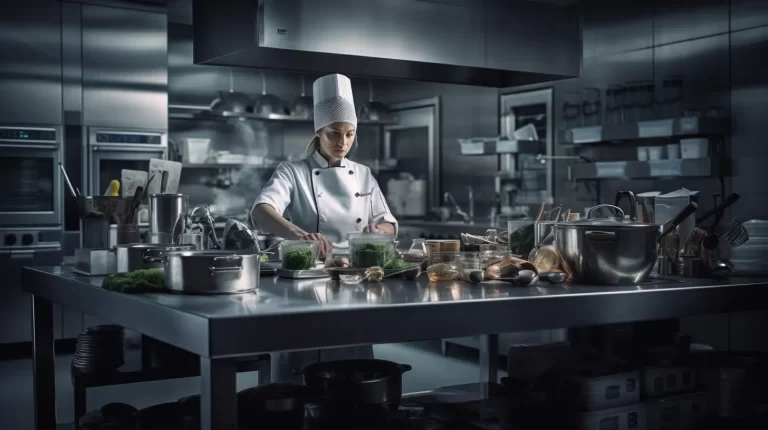
1. Create Fusion Menus
Design a menu for a [type of cuisine] restaurant that integrates [another cuisine’s] flavors, focusing on [specific ingredients]. Include [number] appetizers, [number] main courses, and [number] desserts, ensuring each dish reflects a balance of both cuisines.
2. Explore Sustainable Cooking
Identify [number] sustainable cooking practices and demonstrate how to implement them in preparing [specific dishes]. Focus on [local ingredients] and include suggestions for minimizing waste.
3. Revise Signature Dishes
Reimagine a classic [cuisine’s] dish, [specific dish name], by incorporating modern cooking techniques like [technique]. Provide a step-by-step guide, emphasizing the balance of nutrition and taste.
4. Generate Recipe Ideas
Create [number] innovative recipe ideas that blend [specific ingredients] with [specific cooking method], suitable for [type of meal]. Ensure these recipes align with your culinary style and values.
5. Develop Culinary Workshops
Outline a plan for a culinary workshop focusing on [specific technique or cuisine]. Detail the workshop’s structure, including hands-on activities, ingredient lists, and educational components.
6. Improve Kitchen Efficiency
Propose a systematic approach to improve efficiency in a professional kitchen setting, focusing on [specific area, e.g., prep work or cooking process]. Include step-by-step workflow optimizations.
7. Craft Cookbook Concepts
Develop a concept for a cookbook that reflects your culinary style. Outline [number] potential themes, each with a list of [number] signature dishes that would be included.
8. Analyze Culinary Trends
Analyze the latest trends in the culinary world, focusing on [specific trend]. Discuss how these trends can be integrated into your current project or menu.
9. Evaluate Dietary Adaptations
Create a plan to adapt [specific dish] for [specific dietary restriction, e.g., gluten-free]. Ensure the adaptation maintains the dish’s core flavors and textures.
10. Plan Global Culinary Tours
Design a culinary tour itinerary for [specific country or region], focusing on exploring local cuisines and cooking techniques. Include [number] must-visit places and key dishes to try.
11. Refine Plating Techniques
Showcase advanced plating techniques for [type of cuisine]. Provide a step- by-step guide, including visual examples, for plating [specific dish].
12. Study Culinary Literature
Identify [number] essential culinary books or memoirs from renowned chefs that align with your culinary style and values. Summarize key learnings or inspirations from each.
13. Expand Flavor Profiles
Develop a guide to expanding flavor profiles in [specific cuisine], focusing on unconventional ingredient pairings. Include practical examples for [number] dishes.
14. Enhance Menu Descriptions
Rewrite menu descriptions for [specific menu or restaurant], using enticing culinary language. Focus on vividly describing the flavors, textures, and presentation of each dish.
15. Construct Nutritional Balances
Create a guide for balancing nutrition and taste in [specific type of cuisine]. Include [number] recipe examples that demonstrate this balance.
16. Curate Farm-to-Table Experiences
Design a farm-to-table dining experience, detailing the journey of [specific ingredients] from source to plate. Include partnerships with local farmers and sustainable practices.
17. Innovate Cooking Methods
Explore innovative cooking methods that could be incorporated into your culinary style. Detail [number] methods and how they could be applied to [specific dishes].
18. Optimize Ingredient Sourcing
Devise a strategy for sourcing high-quality, fresh ingredients locally. Include a list of [number] local suppliers and the types of ingredients they provide.
19. Assess Kitchen Tools
Evaluate the efficiency of current kitchen tools and equipment. Suggest [number] upgrades or additions that could enhance your cooking techniques and dish quality.
20. Design Chef Training Programs
Outline a training program for aspiring chefs, focusing on [specific skills or cuisines]. Include practical exercises, theoretical lessons, and evaluation methods.
21. Create Allergy-Friendly Menus
Develop a menu for [type of restaurant] that caters to common allergies, such as gluten-free, nut-free, and dairy-free options. Include [number] dishes for each category.
22. Profile International Cuisines
Conduct a detailed profile of [specific international cuisine], exploring its history, key ingredients, cooking techniques, and classic dishes.
23. Optimize Recipe Development
Formulate a systematic approach to developing new recipes. Include steps for ideation, experimentation, taste testing, and finalizing recipes.
24. Advance Culinary Photography
Compose a guide on culinary photography, focusing on techniques to best capture the essence of dishes. Include tips on lighting, angles, and styling.
25. Streamline Food Preparation
Develop a step-by-step guide to streamline food preparation processes in a professional kitchen, focusing on [specific cuisine or dish types].
26. Cultivate Culinary Creativity
Provide exercises or activities that stimulate culinary creativity, focusing on developing unique flavor combinations and presentation styles.
27. Implement Kitchen Safety Practices
Outline essential kitchen safety practices, focusing on preventing common accidents and maintaining hygiene standards in a professional kitchen.
28. Enhance Team Communication
Develop strategies to enhance communication and collaboration in a kitchen team, focusing on roles, responsibilities, and efficient workflow management.
29. Integrate Technology in Cooking
Explore ways to integrate modern technology, such as sous-vide or smart kitchen tools, into your culinary practices. Include practical applications for [number] dishes.
30. Construct Event Menus
Design a menu for a [specific type of event], considering the event’s theme, guest preferences, and logistical constraints. Include [number] starters, mains, and desserts.